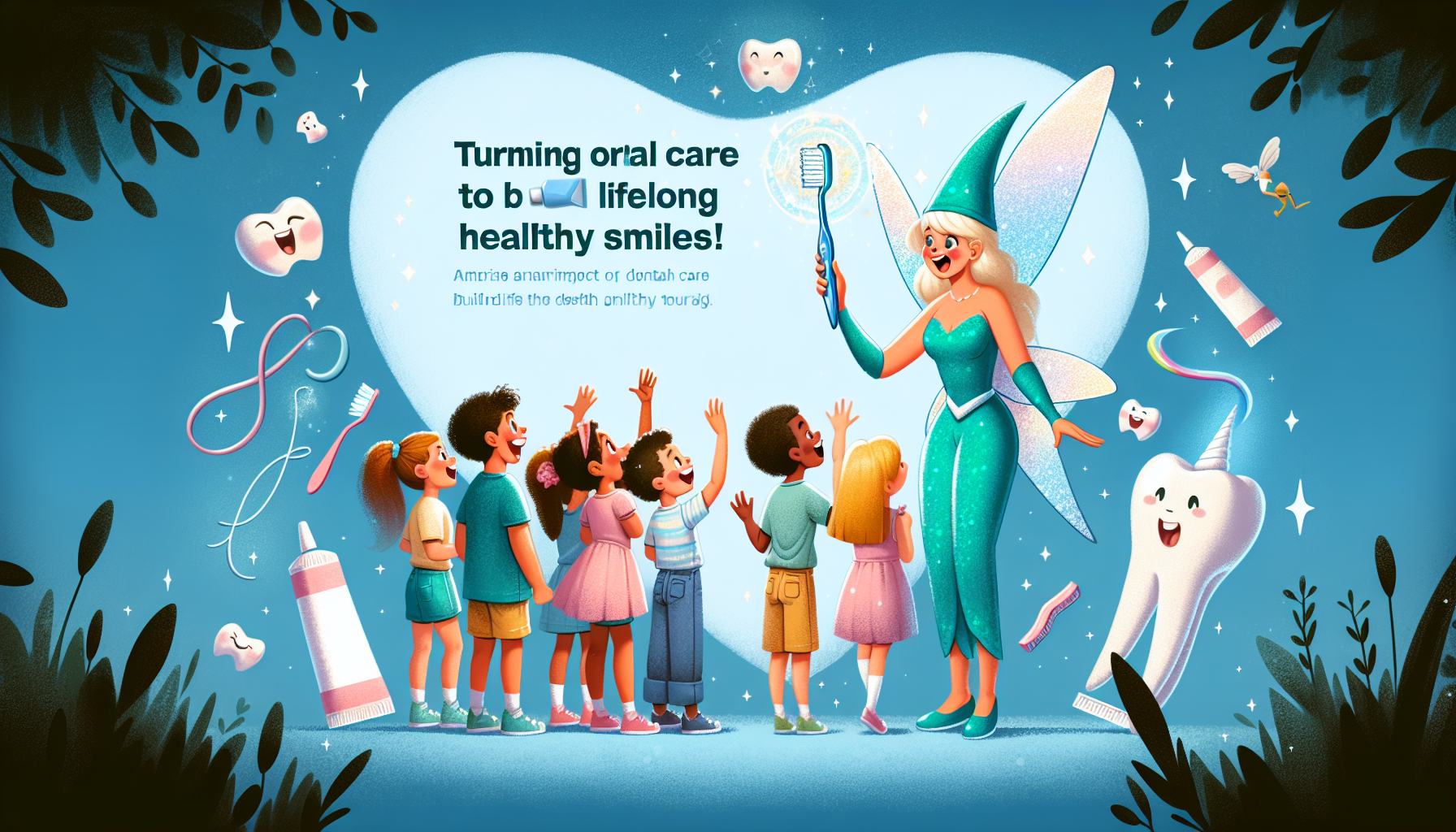Tooth Fairy Tips to Build Lifelong Healthy Smiles
Just like small daily habits can transform your life, consistent dental habits can create a lifetime of confident, healthy smiles. Learn more in The Habit Method.
Why Oral Hygiene Habits Start Early: The Foundation for Healthy Smiles
Good oral hygiene habits formed in childhood often last a lifetime. Early exposure to brushing, flossing, and visiting the dentist can set the stage for ongoing oral health and a positive relationship with dental care.
According to the American Academy of Pediatric Dentistry (AAPD), children should have their first dental visit by age one or within six months of the eruption of the first tooth. Establishing early dental visits helps detect problems such as early childhood cavities and allows parents to receive guidance on home care.
- Baby teeth matter. Even though they eventually fall out, baby teeth help children chew, speak clearly, and hold space for permanent teeth.
- Early prevention works. Children who regularly brush with a pea-sized amount of fluoride toothpaste can reduce cavity risk by up to 40% compared with non-fluoride users. — American Dental Association (ADA)
- Positive habits are reinforced through routine. Kids are more likely to brush and floss consistently when parents model the same behaviors.
Fun and Creative Tooth Fairy Ideas to Encourage Brushing and Flossing
Turning the Tooth Fairy visit into a magical opportunity for learning can motivate children to take pride in their daily brushing. Beyond leaving coins under the pillow, parents can add creative touches that make oral care exciting.
Tooth Fairy Certificates and Rewards for Brushing Milestones
Consider leaving a personalized Tooth Fairy certificate acknowledging your child’s good brushing streak or bravery during a dental visit. Printable certificates and small tokens, such as toothbrush stickers or glow-in-the-dark flossers, can transform dental care into a celebration.
- Download or design a “Brushing Star” award.
- Track streaks with a sticker chart—each week of full participation prompts a “gold coin” from the Tooth Fairy.
- Combine the Tooth Fairy’s visit with new dental gear—like a sparkly toothbrush—to keep the excitement alive.
Glitter Money, Fairy Dust, and Other Magical Tooth Fairy Surprises
Small touches of magic can make oral hygiene memorable. Sprinkle fairy dust (eco-friendly glitter) on a note or use glow-in-the-dark envelopes for the Fairy’s payment. These gestures can link the joy of losing a tooth with maintaining healthy habits.
- Use safe, biodegradable glitter for an eco-friendly sparkle.
- Slip a gentle reminder onto the Fairy’s note: “Great brushing keeps Fairy wings shining bright!”
- Hide the reward near the sink to encourage morning brushing.
Encouraging Good Dental Habits Through Tooth Fairy Letters
Writing a letter from the Tooth Fairy allows parents to reinforce healthy behavior in a creative way. A short, cheerful message congratulating your child for caring for their teeth reinforces both positive language and self-esteem.
Examples of encouraging phrases include:
- “Your shiny tooth shows how well you’ve been brushing twice a day!”
- “Keep flossing to help your big teeth grow in strong and bright.”
Personalized communication builds connection and encourages consistency — essential for building lifelong habits.
Positive Reinforcement: Turning Oral Care into a Rewarding Routine
Praise and encouragement are powerful motivators for children. Research in behavioral psychology shows that positive reinforcement is more effective for establishing long-term habits than punishment or correction alone. — Journal of Pediatric Psychology
- Celebrate effort, not just results. Recognize when your child brushes without reminders.
- Visual reward systems work. Sticker charts or digital brushing apps can track progress in fun, interactive ways.
- Keep rewards healthy. Non-sugary prizes—like a new toothbrush, bedtime story, or extra playtime—align with your oral health goals.
Small daily wins, such as brushing success or a cavity-free checkup, can nurture intrinsic motivation and pride in taking care of their smile.
Building a Bedtime Brushing Routine Before the Tooth Fairy Visits
Bedtime is one of the most important times to brush since plaque and bacteria accumulate overnight. Developing a consistent evening brushing and flossing ritual reinforces responsibility and cleanliness before sleep.
- Make it part of bedtime rituals. Pair brushing with stories or calming music for a smooth transition.
- Play interactive brushing games. Parents and children can pick songs that last two minutes—the recommended brushing time—to make it fun.
- Teach technique through demonstration. Parents brushing alongside children helps correct their motions and builds accountability.
The ADA recommends brushing twice daily for two minutes each time with a soft-bristled toothbrush and fluoride toothpaste. — ADA
How Parents Can Foster a Lifelong Love for Healthy Teeth
Children learn most behaviors through modeling, and oral health is no exception. Parents who prioritize their own dental care show that oral hygiene is both normal and important.
- Model consistency. Brush and floss together for family accountability.
- Schedule regular checkups. Pediatric dental visits every six months build familiarity and comfort with dental care settings. — AAPD
- Use positive language. Replace fear-based terms (“it won’t hurt”) with empowering words like “healthy,” “strong,” and “sparkly.”
- Provide educational resources. Age-appropriate books and videos demystify oral health and make learning interactive.
Children who perceive dental visits as friendly and supportive are more likely to maintain consistent care as adults, leading to fewer cavities and better oral health outcomes.
Problem: The Challenge of Getting Kids Excited About Brushing
Studies show nearly 40% of children miss at least one brushing session per day. — Centers for Disease Control and Prevention (CDC) The result? Early childhood caries (tooth decay) remains the most common chronic disease among children aged 6 to 11.
Lack of motivation, inconsistent routines, and fear of dentists are frequent barriers—but integrating familiar traditions like the Tooth Fairy helps overcome them. By linking dental care to joy, recognition, and play, parents can shift brushing from a chore into a point of pride.
Solution: Making Oral Health Magical and Habitual
The Tooth Fairy tradition can be a simple, evidence-based behavioral tool to promote hygiene through positive reinforcement. Experts in pediatric dentistry recommend combining creativity with structure: consistent routines, visual reminders, and tangible rewards all support habit formation.
Research shows children internalize values more effectively when learning is playful and emotionally engaging. When a child views brushing through the lens of fairy-tale magic, they are more likely to do it voluntarily. Over time, that consistency transforms short-term excitement into long-term oral health behavior.
Frequently Asked Questions
- 1. At what age does the Tooth Fairy usually visit?
Most children lose their first tooth around age six, but timing can vary. The Tooth Fairy can start visiting once the first baby tooth falls out naturally. - 2. How can I use the Tooth Fairy to encourage better brushing?
Pair rewards with recognition. Leave notes from the Tooth Fairy congratulating your child for consistent brushing or bravery during dental visits. - 3. What type of rewards are healthiest?
Opt for non-sugary treats, such as a new toothbrush, small toys, or extra playtime. Avoid sweets that can harm newly erupted permanent teeth. - 4. How do I make brushing fun for my toddler?
Play a two-minute brushing song, let your child pick a favorite-flavored toothpaste (fluoride-based), and use colorful toothbrushes to keep engagement high. - 5. When should I schedule my child’s first dental visit?
The AAPD recommends scheduling the first appointment by age one or six months after the first tooth appears. Early visits help detect cavities and educate parents.
Conclusion
Small, joyful traditions like the Tooth Fairy can spark meaningful dental habits that last a lifetime. By making oral care fun, rewarding, and consistent, parents nurture both confidence and health. Regular brushing, healthy rewards, and early dental visits form the foundation for strong, cavity-free smiles that grow with your child.
Just as consistent routines lead to lifelong wellness, habit-building in oral hygiene can transform your family’s smiles for generations. Explore more about forming everyday habits that stick through The Habit Method.
Post Disclaimer
DentalUp is for educational purposes only and cannot accept personal dental information such as x-rays, photos, or treatment details. See full disclaimer here.





